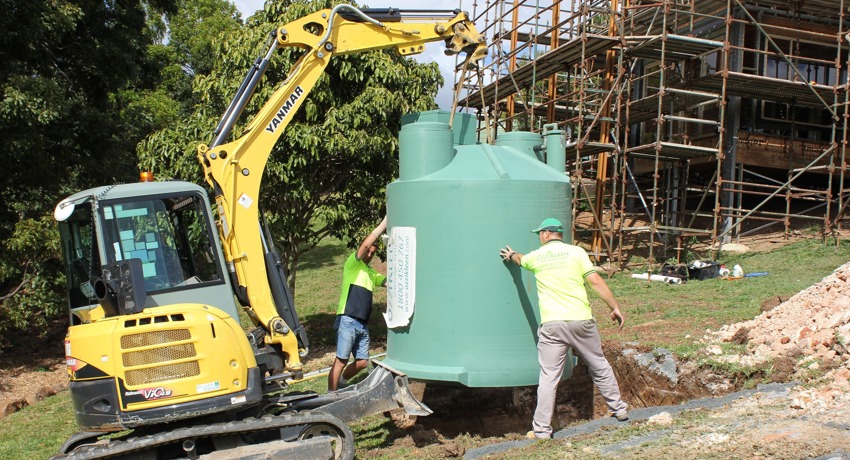The Sustainable Choice: Poly Tanks for Sewage Treatment

The Sustainable Choice: Poly Tanks for Sewage Treatment
Date: 23-Aug-2023
Sewage treatment is a crucial aspect of modern urban development, aiming to protect the environment and public health by effectively managing wastewater. When it comes to selecting the right sewage treatment tanks, the choice between traditional concrete tanks and innovative poly tanks has become a topic of interest. While both options serve the purpose of sewage treatment, poly tanks offer a range of advantages that make them a sustainable and efficient choice. In this article, we will delve into the differences between concrete and poly tanks, highlighting the benefits of poly tanks and why they are the more favourable option for sewage treatment.
Material Composition and Durability
Concrete tanks have been a conventional choice for sewage treatment due to their longevity and strength. However, advancements in materials have introduced poly tanks as a worthy alternative. Polyethylene, the primary material used in poly tanks, is incredibly durable, resistant to corrosion, and does not crack or deteriorate over time like concrete. This inherent durability translates to longer tank lifespans and reduced maintenance requirements.
Installation and Weight
One significant advantage of poly tanks is their lightweight nature. Concrete tanks, although sturdy, are extremely heavy and require specialised equipment and skilled labour for installation. Poly tanks, on the other hand, are much lighter, making installation easier, quicker, and more cost-effective. This also reduces the need for extensive site preparation and can minimise disruption to the surrounding environment during installation. Furthermore, it makes poly tanks a far more suitable option for steep sloping or hard to access properties.
Environmental Impact
In an era where sustainability is a paramount concern, poly tanks have a clear advantage. Concrete production is energy-intensive and releases a substantial amount of carbon dioxide into the atmosphere, contributing to greenhouse gas emissions. The production of polyethylene tanks, while not completely free of environmental impact, generates significantly fewer emissions. Furthermore, when considering the entire lifecycle of the tanks, including manufacturing, transportation, and disposal, poly tanks often have a lower overall carbon footprint.
Aesthetically Pleasing
Poly tanks offer a high degree of design flexibility, such as the ability to customise the colour of your tank. Furthermore, unlike concrete tanks, which need to have the full top visible, poly tanks can be almost fully buried within your garden and the small above ground components are able to be easily disguised within a garden.
Resistance to Chemicals and Corrosion
Sewage treatment involves exposure to various corrosive and chemically aggressive substances. Concrete tanks may be susceptible to degradation over time due to chemical exposure, requiring frequent maintenance and potential repairs. Poly tanks, however, exhibit excellent resistance to a wide range of chemicals and corrosive agents, ensuring long-term performance and minimal maintenance needs.
Insulation Properties
Poly tanks exhibit natural insulation properties that can be advantageous in both hot and cold climates. Unlike concrete, which conducts heat and cold, poly tanks help maintain a more stable temperature within the tank. This characteristic can aid in optimising the biological processes involved in sewage treatment, leading to more efficient and consistent treatment results.
Ease of Maintenance
Poly tanks are inherently low-maintenance compared to their concrete counterparts. Their smooth, non-porous surfaces hinder the buildup of solids and debris, reducing the frequency of cleaning and maintenance. Additionally, polyethylene is resistant to biological growth, decreasing the likelihood of clogs and blockages within the tank.
Cost-effectiveness
When considering the entire lifecycle cost, poly tanks often prove to be more cost-effective than concrete tanks. While the initial purchase cost of poly tanks may be slightly higher, the savings in installation, maintenance, and potential repairs over time can make them the more budget-friendly choice in the long run.
Recycling
Ozzi Kleen is the only waste water poly tank manufacturer in the world to use up to 80% recycled Plastic. Also the tank can be 100% recycled in the future if ever needed unlike concrete and fibreglass.
As the world continues to focus on sustainable practices, it's important to evaluate every aspect of urban development, including sewage treatment. While concrete tanks have been the traditional choice, the benefits of poly tanks cannot be ignored. From their lightweight nature and customisation possibilities to their environmental friendliness and resistance to corrosion, polyethylene tanks present a compelling case for being the superior option for sewage treatment.
While both concrete and poly tanks have their merits, poly tanks offer a modern and forward-thinking solution that aligns with the principles of sustainability and efficiency. As urban populations grow and environmental concerns escalate, embracing innovative alternatives like poly tanks becomes essential for responsible sewage treatment practices.
If you would like to learn more about Ozzi Kleen poly tank home sewerage treatment plants, or to request a quote, please contact us on 1800 450 767.
Ask us about a water system Find a Distributor Back to articles
